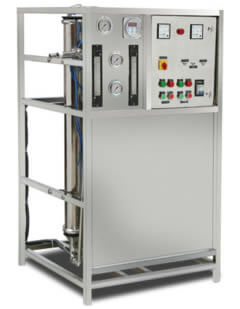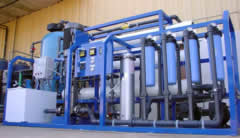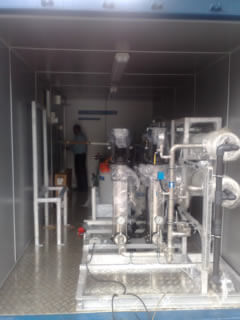Reverse osmosis Plants [RO Plant]
Reverse osmosis is the process of forcing a solvent from a region of high solute concentration through a membrane to a region of low solute concentration by applying a pressure in excess of the osmotic pressure. This is the reverse of the normal osmosis process, which is the natural movement of solvent from an area of low solute concentration, through a membrane, to an area of high solute concentration when no external pressure is applied. The membrane here is semipermeable, meaning it allows the passage of solvent but not of solute.To illustrate, imagine a semi permeable membrane with fresh water on one side and a concentrated aqueous solution on the other side. If normal osmosis takes place, the fresh water will cross the membrane to dilute the concentrated solution. In reverse osmosis, pressure is exerted on the side with the concentrated solution to force the water molecules across the membrane to the fresh water side.
The membranes used for reverse osmosis systems have a dense polymer barrier layer in which separation takes place. Since Reverse Osmosis does not occur naturally, it must be created by applying pressure to the high solids water in order to force it through the membrane, with pressures from 8 - 14 bar for fresh and brackish water, and 40 - 70 bar for seawater, which has around 24 bar (350 psi) natural osmotic pressure which must be overcome.
Design Considerations for RO Plant
Fluid Systems RO Plants work on the Crossflow Filtration method, which takes the feed water and uses a percentage of it as a wash or reject stream, removing the solids during the filtration process.The product flow of an RO Plant is mainly a function of temperature and pressure. System recovery (product divided by feed) is limited by the characteristics of the feed water and can be controlled through the use of recycle stream. Product quality is based on a percentage of dissolved solids fed to the membrane. There should be an economic balance between product quality and system recovery. High recoveries increase concentration of dissolved solids in the system which degrades quality, but high recoveries make the system work more efficiently and decrease waste.
Reverse Osmosis Plants do not deliver to service all of the water that is fed to them. During operation, some of the incoming water is used to wash down the membrane, and only part becomes finished product water. Purified water is referred to as product and wastewater is referred to as concentrate, or reject. The percent of water delivered as product is called the recovery, and depends upon the membrane and on total RO Plant design considerations.
Pretreatment – Reverse Osmosis Plants
The feed water, depending on its source, may contain various concentrations of suspended solids and dissolved matter. Suspended solids may consist of inorganic particles, colloidal particles and biological impurities such as microorganisms and algae. Dissolved matter may consist of highly soluble salts, such as chlorides, and sparingly soluble salts, such as carbonates, sulfates, and silica.During the Reverse Osmosis process, the volume of feed water decreases, and the concentration of suspended particles and dissolved ions increases. Suspended particles may settle on the membrane surface, thus blocking feed channels and increasing pressure drop across the system. Sparingly soluble salts may precipitate from the concentrate stream, create scale on the membrane surface, and result in lower water permeability through the RO membranes. This process of formation of a deposited layer on a membrane surface is called membrane fouling and results in performance decline of the RO system. The objective of the feed water pretreatment process is to improve the quality of the feed water to the level which would result in reliable operation of the RO membranes. Based on the raw water quality, the pretreatment process for RO Plants may consist of all or some of the following treatment steps:
- Clarification followed by Sand Filtration for Turbidity removal
- Water disinfection with chlorine
- Hardness reduction by Softening
- Addition of scale inhibitor
- Reduction of free chlorine using sodium bisulfite/ Activated carbon filters
- Final removal of suspended particles using cartridge filters
RO Plants - Post Treatment
Based on the Output water quality required, the post treatment process for Reverse Osmosis Plants may consist of all or some of the following treatment steps- ozonation
- Ultra-violet
- chlorination systems
We Offer a wide range of Reverse Osmosis Plants [RO Plants]
Residential Reverse Osmosis Purifiers:We Offer a range of RO Water purifiers in 3/5 stage purification modules in below flow configurations:
- 10 LPH RO Purifiers
- 20 LPH RO Purifiers
- 25 LPH RO Purifiers
Commercial RO Systems / Institutional RO Systems
One of our most popular series, the Commercial RO usually comes in standard Models. These Commercial RO Systems can be customized to add Multimedia Filters & Activated carbon Filters, Water softeners, Antiscalant Dosing Systems, and UV sterilizers.These systems are used to purify water and remove salts and other impurities. It is also capable of rejecting bacteria
The Main features of these RO Plants are:
- Microprocessor based Control Panel
- Powder coated frame
- 20 & 5 micron sediment pre-filter
- Stainless Steel Multistage High pressure pump
- FRP pressure vessel
- Product and Reject Flow Meters
- Low & High pressure switch
- High rejection TFC membranes
- Heavy duty high pressure tubing
- Pressure gauges
These Commercial/Institutional RO Systems are available in following Flow Ranges:
- 200 LPH RO Plants
- 250 LPH RO Plants
- 400 LPH RO Plants
- 500 LPH RO Plants
- 750 LPH RO Plants
Higher flow Rates can also be custom-built as per Customers requirement
Industrial RO Plants/ Industrial RO SystemsWe manufacture a wide Range of industrial Reverse Osmosis Plants to cater the stringent process requirements. Our industrial reverse osmosis Plants are carefully customized and configured to suit the individual requirement of the output water, which varies from normal drinking application to the specific usage, such as food Processing, pharmaceuticals and boiler feeding requirement.
These systems come standard with pre-filters, chemical dosing and Antiscalant dosing. Customization is available on all our units based on individual water application and customer needs.
- Microprocessor based Control Panel
- 4" & 8" TFC spiral wound membranes
- FRP membrane housings
- Epoxy painted steel frame
- Stainless steel High Pressure Multi-stage pump
- 20 & 5 micron cartridge filter
- Low & High pressure switch
- Glycerin filled pressure gauges
- Permeate & concentrate flow meters
- Outlet Conductivity meter


